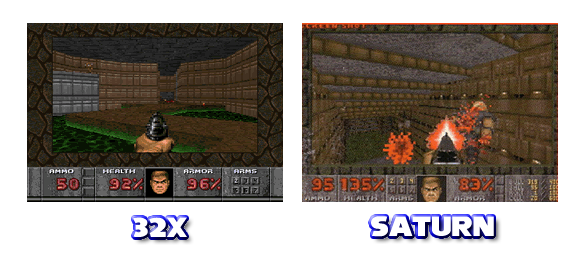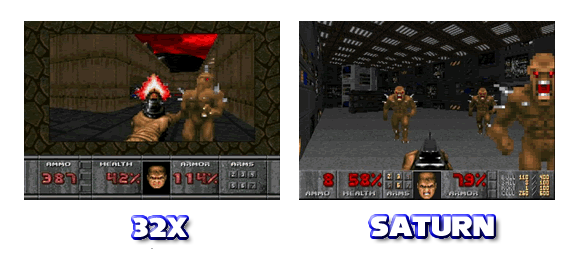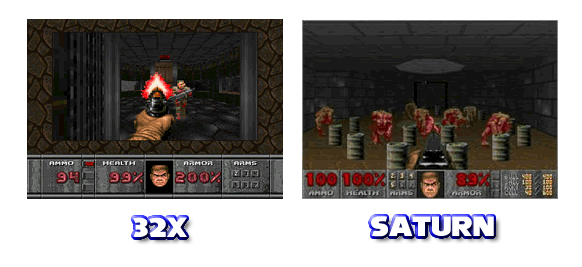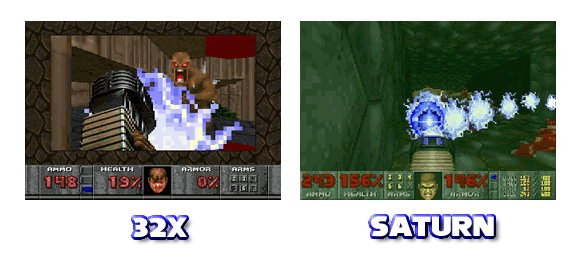I had a distinct feeling as I sat down to type out this article, that it would be a bit different from all the other Side by Sides we’ve seen so far at Sega-16. It’s true that Ken’s Virtua Fighter match up was very similar – 32X versus Saturn – but I think this must be the first showdown where both games are trying their hardest to lose instead of win. That is why I, your valiant guide for today’s romp, will try my best not to indulge in the fanboy cries of “omg, I can’t decide which roxxors more!” (Do you detect the sarcasm?) Make no mistake, gentle reader – the Saturn and 32X ports of Doom are among the worst in existence. Yes, that’s counting the SNES one.
Does this game really need an introduction? Surely you know the drill by now, guys. Doom, DooM, DOOM, whatever – it’s the shareware phenomenon, courtesy of id Software, that finally pushed 2D gaming from the mind of the common gamer and made popular an entire genre called first person shooters. During its era, it was enthralling, exciting, addictive, and racy as only hell can be. It, more than Wolfenstein 3D before it, is the great granddaddy of all the multi-million dollar franchises we enjoy today: Halo, Half-Life, Quake, Unreal, and all the rest.
Predictably, the Doom cash cow was to be milked until dry. Sixteen official ports exist as of the writing of this article, and you can be sure that more will continue to surface as long as games are made. In addition, there are countless homebrew and fan-made ports to almost every piece of hardware under the sun, from mobile phones to iPods. (And the rest, like the Genesis and Atari 2600, have had elaborate hoaxes of Doom ports.)
The clutching fingers of Doom reach far and wide, to be sure, and have done so since its release in 1993. So who is surprised that it managed to find its way to both the Sega Saturn and 32X? Admittedly, the two ports were released under very different circumstances. On Sega’s mushroom-like add-on to the Genesis, Doom was a vital launch title released during the heyday of its popularity, an essential key to moving the 32X off store shelves. With the Saturn, however, Doom was something of a throwaway – four years too late and already overshadowed by newer, truly polygonal offerings like id’s own Quake.
It’s now time to analyze the two games and see how they stand against each other in four categories – presentation, sound, graphics, and gameplay. Throughout we’ll also be considering each port’s faithfulness to the DOS/IBM PC originals from whence they were spawned. But before we get started there must be a word of clarification: for the purposes of this match up, Saturn Doom will refer to the US NTSC and PAL editions, as opposed to the Japanese NTSC release. More on that later.
Let’s get it on, folks. Brace yourself.
The Differences
Presentation: It sort of kills the drama to have this category first, as it reveals right from the get-go the biggest problems with both versions. Some negatives are more obvious than others, though. With the 32X, you can see from the moment you boot the game that there is a huge border running around the screen, with gameplay taking place in a small, centered window. It’s a common trick in early first-person shooters – making the screen smaller in order to reduce the amount of stuff onscreen and reduce the strain on the processor, thereby increasing frame rate (the smoothness and speed at which the game operates). A worthy goal, but last I checked, borders and small screen sizes do not make for an impressive score in presentation. The Saturn sports a more familiar full-screen display. Unfortunately, it also sports an absolutely atrocious frame rate.
This, friends, is a very low blow for the Saturn. To me it is absolutely unacceptable that Saturn Doom can’t offer a smooth gaming experience. This is a 2.5D game, people. Note that I don’t lay the blame on the hardware itself, as we’ve all seen the Saturn push Quake‘s comparatively monstrous rendering demands at much more impressive speeds. No, my seething hatred must fall entirely on Rage Software for their abysmal coding job. Saturn Doom came out in 1997, a full four years after Doom‘s initial release and almost two years after the Saturn itself hit the shelves, leaving Rage no wiggle room for excuses. If they’d cared about presenting a quality product, they would have optimized their engine and taken full use of the Saturn’s dual processors.
Remember that initial scene, in the room with the four pillars and the stairs leading to the armor off to the right? That scene runs at about five or ten frames per second. When I saw that, my jaw hit the floor – and stayed there for the remainder of the game. How in the world can the game be so choppy when there’s nothing onscreen? No power ups, no enemies, no fireballs, nothing. I had been expecting Doom, not Myst, and all the reviews in the world couldn’t possibly have prepared me for that. The 32X had its choppy moments as well, sure, but on the whole I found 32X Doom to run at approximately three times the frame rate of Saturn Doom.
Another problem I have with the Saturn is how dark everything is, even in open-sky environments that should be lit well. Although dimness can be creepy at times, I think it’s overdone in the port, and it sometimes gets downright silly. (Not being able to see in a corridor lined with fluorescent lights? Come on!) Personally I suspect that there’s a clip line just behind that blackness, which makes the choppiness even harder to take. Any sort of gamma correction would have been welcome. The 32X was either fully lit or fully dark, true, but at least you weren’t stumbling around in the dark during high noon.
One thing the Saturn does right is the flow of gameplay. We finally get to see the (over?) dramatic text intermissions and true ending sequence. The 32X felt like some sort of test alpha with its lack of transitions and canned demon slide show/credits roll. Points to Saturn, but not enough to win the category.

Edge: 32X.
Graphics: This is where the cartridge hits the fan for the 32X. While it was able to push environments at an enviable pace, it falls apart in the face of the Saturn’s insurmountable data storage advantages and graphics output capabilities. The list is endless… The 32X has bland color, the Saturn is vivid; there are whole monsters and weapons missing from the 32X, the Saturn has almost all of them; monsters cannot retreat or turn sideways on the 32X, the Saturn retains all of the animations; there are no level names on the 32X, the Saturn has them. It’s that next-to-last complaint that most damages the 32X’s cause. Without being able to sneak up on enemies or bait baddies into infighting, much of the Doom feel is lost. Come on, who can forget when you were surrounded by Barons of Hell, only to see them suddenly turn on each other while you limped off during the chaos?
Other animations were cut from the 32X roster as well, like many of the Space Marine Avatar’s expressions. To the 32X’s credit, it pulls off some charming, if a little crude, atmospheric lighting effects. But the Saturn does the same thing, only bigger, bolder, etcetera. This is no surprise, so there’s no reason to dally on minutia. A very definitive win for the Sixth Rock From the Sun.

Edge: Saturn.
Sound/Music: The 32X provided only minimal upgrades for the Genesis’ audio system, and if we dispense with the technicalities it’s pretty fair to say that 32X sound IS Genesis sound. As such, and in conjunction with the limitations of the cartridge format, you would expect the Saturn Doom to soundly mop the floor with the 32X. But hilariously enough, the Mushroom-that-Could gets its digs in by boasting clearer sound effects than its CD-based competition – just like with Virtua Fighter. Saturn gamers still rue the lack of hardware audio compression to this day…
When it comes to music, of course, the 32X’s on-the-fly synthesized tracks can’t compete with Doom‘s red book audio in terms of quality. Saturn wins, right? Well, not just yet. Thing is, the Saturn port – just like the PSX version before it – does not use the familiar and much-loved original soundtrack. Instead, it uses an array of generic horror ambience tracks, composed mostly of random ‘eerie’ sound effects and half-melodies. So, no thrashing guitar solos. I’m no ‘my-Cacodemon-is-three-pixels-wider-than-your-Cacodemon’ Doom purist, but to me the rock-cover tunes of the original Doom are an essential part of the experience. So in that respect I actually like the 32X MIDIs over the Saturn’s CD audio. Incredibly, I must declare this category a 32X win.
Track 17, Saturn Doom (MP3 format, 2.93 megs) At Doom’s Gate, 32X Doom (MP3 format, 1.47 megs)
Edge: 32X.
Gameplay: I’m trying to forget the choppy graphics, but the problem is that such frame rate woes adversely affect almost all aspects of the game. Neither the 32X nor the Saturn are anywhere near as fast-paced and hectic as the IBM PC and DOS editions. And assuming that fast, raging massacres are mostly the point of Doom, both ports basically miss the target completely. It’s one of those cases where just because something looks like Doom and sounds like Doom, doesn’t really mean it is Doom.
Both the Saturn and 32X renditions were both seemingly rushed out the door in an attempt to get a product with the proper moniker to the shelves and start raking in the dough. This, more so than the third-rate programming, is the most serious insult to Sega fans and supporters. The producers didn’t care about quality, they cared about cash flow. There’s no reason we couldn’t have had a great port of Doom on the 32X and an even better (possibly perfect) one on the Saturn – if the conversion teams had been allowed to work out the bugs and streamline the presentation.
On the bright side, controls are refreshingly good. Between dual-direction cyclic access and shortcut combinations, the 32X gives very tight control over weaponry, and the Saturn’s triggers let you circle strafe with ease. Somewhat dousing my enthusiasm is the sluggish acceleration/deceleration afflicting both ports. I was running into walls and overshooting doorways regularly for the first few levels until I got the hang of it.
As for the rest, well…you know how Doom goes. Kill enemies, get a key, blast baddies, open a door, toast demons, grab a power up, obliterate specters, upgrade your weaponry, kill, maim, destroy, destroy, destroy. One can say very truthfully that Sega was not kind to Doom, but one can also say that time itself has not been kind to Doom. In many ways, no other game has been so completely surpassed by its successors. John Romero’s comment that equated plot in video games to plot in porn films now seems foolish in the light of epics like Half-Life 2; similarly, the total action approach of Doom has become somewhat stale. Sure, there are people who still laud its simplistic goals and pure carnage-over-anything-else attitude, but in my opinion the 100% run-‘n-gun formula has been rendered obsolete by more modern balances of strategy, teamwork, and story.

Edge: Draw
Other: It’s interesting to note that the 32X Doom only contains the first two episodes of the original DOS game (minus the Tower of Babel), whereas the Saturn sports all but eight missions from The Ultimate Doom. Better yet, Saturn Doom actually contains Doom II as well, with only a few missing maps. So, with the 32X you basically get the limited-map shareware edition of the original from 1993, whereas with the Saturn you get the commercial release of both The Ultimate Doom and Doom II – including all the additional monsters and miscellany. A strong argument in favor of Saturn Doom, to be sure. Both add extra levels to replace the lost ones, but here again the Saturn wins out. The 32X only throws in two bonus maps, while the Saturn offers a much more satisfying eight. In the end it’s fifty-nine versus seventeen. In both cases, none of the maps are perfect copies of the originals. All have been edited and simplified, albeit in ways unobtrusive enough to bother only the most die-hard fans.
One could go on for pages about all the minor differences between these ports and the PC originals, but to do so is beyond both the scope of this article and the patience of Sega-16’s readership. To find out more information like the three-pixel-fatter Cacodemon mentioned above, check out the venerable (and exhaustive) Doom Comparison Guide, courtesy of ClassicDoom.
Another ironic bit of trivia is that both ports have downright untruthful packaging. The 32X box depicts enemies capable of moving sideways and fails to depict the unholy border around the screen, while the Saturn version ludicrously claims to have death match capabilities through a link cable. Quality assurance, where did you go?
Lastly, a word must be said about the myriad of glitches and oversights on the 32X. Your rockets fly with their nose pointing you, for instance, and the game often locks up without warning. There are errors in the maps that prevent you from killing all the enemies, some of the teleporters are non-functional, the almighty BFG 9000 is only available in a cheat code, and so on. More evidence that 32X Doom was rushed to release date beyond the acceptable limits.

Edge: Saturn
Final Assessment
Saturn wins two categories, 32X wins two, with one draw. So it’s a tie, right? No, I’m actually going to give the win to the 32X. The Saturn’s unholy frame rate issues destroyed my enjoyment completely, rendering its extra maps not much more than forty-two more sessions of pain. The 32X Doom, with all its problems, actually gave me more fun than its more powerful relative. Some, of course, will accuse me of underdog favoritism. To them I can only say that the truth is actually the exact opposite – I went into this article wanting the Saturn to win, but was so horrified by its shortcomings that I was prompted to give a second, more serious look at the 32X. A job well done to the ‘Shroom. As time goes on, it seems like the much-maligned 32X only gains respect. Hopefully this Side by Side will speed that process.
There is a disclaimer, however, and it has to do with the clarification at the beginning of this match up. Remember how I said that all of this only applies to the U.S. and European versions of the game? It’s time to explain that. You might have heard by now that the Japanese release of Saturn Doom has a higher frame rate. I’ve had the chance to test this myself and can report that it’s true. Not as fast as on a PC, possibly, but orders of magnitude faster than either the U.S. release or the 32X. See it for yourself on these YouTube videos. So, if you’ve got the chance I would actually *recommend* buying the import version of the Saturn game. It’s got all the maps and graphics of Saturn Doom, but with none of the frame rate problems. All in all, it’s a package that severely trounces the 32X. But in this battle of U.S. Dooms? 32X is King.

Recent Comments